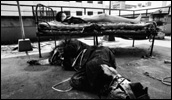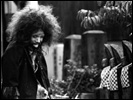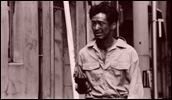Noisy Requiem
- Year
- 1988
- Original title
- Tsuito no Zawameki
- Japanese title
- 追悼のざわめき
- Director
- Cast
- Running time
- 150 minutes
- Published
- 13 September 2006



by Johannes Schönherr
Osaka still has some exquisitely dirty corners that have successfully resisted all urban clean-up campaigns. Of course, to Tokyo-ites the whole city may seem untidy and virtually all its inhabitants may come off as particularly rude folk. Well, Osaka is an old hustle-and-bustle merchant city and the customs are a bit different there from the capital, with all its masses of government bureaucrats. But there are some areas where even tough-mouthed Osakans rarely venture. Take Shin Sekai, for example. It translates as "New World", and that's exactly what it once was supposed to represent. Various grand-scale EXPO-like events were staged there in the late years of emperor Meiji (that means in the 1910s) and the Tsutenkaku Tower, a sort of smaller version of the Eiffel Tower, is still the major landmark of the area, dating back to those times when a young and hungry Japan was challenging the world.
To build all those grand monuments of a rapidly modernizing Japan, large numbers of day laborers were drafted in, and most of them ended up staying on... slowly turning the "New World" into their world. Today, the Kamagasaki neighborhood of Shin Sekai is Japan's biggest homeless area and the closest thing Japan has to an actual slum area. The rest of Shin Sekai either turned to the red-light business or remained trapped and frozen in time. Walking through the shopping arcades there today with their cheap and trashy thrift stores and plethora of drinking outlets is like stepping back in time... like entering the movies and going straight back to 1962 at one corner or to 1973 at another. Never back to a happy past, though, but back to a desperate post-war Japan mired in poverty.
This area is the setting and location of Yoshihiko Matsui's radically nihilist Noisy Requiem. This black and white movie opens with a freeze frame of the main character Makoto (Kazuhiro Sano) walking straight through the homeless ghetto of Kamagasaki. The freeze-frame springs to life, and he walks absent-mindedly towards the camera. Cut to him feeding pigeons in the park, then taking out a claw-hammer and killing a bunch of them. Whistling, he lays down on a park bench and rips the heads off the dead birds. Shots of ghastly homeless shuffling through Kamagasaki, shots of Makoto killing women in dirty backlots next to busy railway lines, cutting organs out of their bellies and stuffing them in a garbage bag. Makoto and a mannequin doll on the rooftop of the abandoned warehouse where he lives. He cuts the mannequin a vagina and stuffs the bloody entrails of the murdered women in there.
We are still right at the beginning of the movie at this point, and not a line of dialog has been spoken. The first spoken lines come from two uniformed schoolgirls who wander through the park where Makoto has killed the pigeons.
While they sit down near two blind war veteran buskers, one of them tells her previous night's dream to the other. There was a boy feeding pigeons, she says, and there was one white pigeon that couldn't get any of the grain because the many other grey pigeons constantly got in its way. So, the white pigeon turned black ... it became a crow. Suddenly the scenery changed, she explains, crows fed on thousands of dead people. The white pigeon that had turned into a crow joins in. The girl walks over to the buskers and gives them some money, then continuing: "Everybody turns into a crow when they're hungry."
Now, this is the key line of the movie. All characters in the film are desperately hungry for something humane: mainly for love but for some characters a little bit of tender attention or at least some basic form of acceptance will do. Being constantly denied any of this, they all turn into vicious crows. Or rather, extremely troubled humans. Shortly after the girls leave, Makoto enters the scene. He insults the busking war veterans and questions the war credits they claim, accusing them of being "lazy Koreans" who "did nothing during the war". He gets his claw hammer out and ... well, I'm not going to describe the scene. You've got to watch it. Interesting thing is, though, that Makoto comes off at that moment as an extreme Korean-hating fanatic. In fact, later moments in the movie suggest that he is more likely to be a closet Korean himself.
The plot continues with Makoto getting a job as an underground sewage line cleaner, working for an incestuous brother-sister midget couple. He is wildly in love with the mannequin he has stuffed with the organs of the women he had killed - in order to give it the means to bear his child. A crazy, sex-starved bum who takes advantage of the same mannequin when Makoto is not around will meet a gruesome fate in a particularly memorable scene.
In short, virtually everybody who shows up in the movie has already reached the end of the line in some respect at the point at which they are introduced... they had already been transformed from the virgin white pigeons to the black crow. But from the moment they appear, things get invariably worse for all of them. Death is the only way out and death doesn't come easily in this film.
Add to that the rough guerilla street-level b&w photography done right in the midst of the Kamagasaki homeless area and a cast that includes a host of truly bizarre characters played by unknown but terribly convincing actors and you got a movie that looks like its emerged straight out of hell. And with guerilla filmmaking I mean guerilla filmmaking: I don't know about any other Japanese filmmaker who would have a character of his film setting the entire rooftop of an abandoned building right in the middle of the city on fire, obviously without any permission, film it from a neighbouring rooftop, then sneak back and shoot the unsuspecting firefighters as they are dealing with the inferno.
When writer-director Yoshihiko Matsui finished his script, nobody thought there would be any way of transferring those typed pages into actual images on celluloid. By that time, in 1983, Matsui had already been a member of Shuji Terayama's radical avant-garde theater group for a few years. Terayama, himself no stranger to controversy over his works (especially his ground-breaking film Emperor Tomato Ketchup from 1971) and generally being considered one of most provocative Japanese artists of the time, commented: "It would be a scandal if this script were actually to be made into a motion picture."
Matsui, however, had an extensive background in no-holds-barred filmmaking and he had heard the word "impossible" too many times before to be bothered by such comments. He had been a founding member of Kyo-eisha, the filmmakers' group led by Sogo Ishii when he started out as a film student making punk rock biker movies in the 1970s. Matsui worked as assistant director on quite a number of those early Ishii adrenaline overflow adventures, like on his 1976 Panic High School and his roller-coaster biker battle pic Crazy Thunder Road (1980). Ishii himself was the director of photography on Matsui's first own production Rusty Empty Can (1979). Matsui's second film, Pig-Chicken-Suicide (1981) was a painful examination of a failed love story between a Zainichi boy and girl. Though graphic in the details (lots of animal butchery) and featuring a final scene of the girl masturbating in her room to Emperor Hirohito's speech announcing Japan's surrender in the Pacific War while the boy is spying on her before being blown off her veranda by a rainstorm, Pig-Chicken-Suicide was a rather experimental film, requiring a very sober and focused mind to make sense out of what actually happened on screen. Very different from Ishii's high-speed works but somewhat closer to Terayama's often mysterious experiments.
With Noisy Requiem, Matsui finally found his own unique voice: slow-paced, intense, cruel, and telling a tale of epic proportions. It took him 5 years to realize the movie but when it finally premiered in 1988, it became an instant success on the Japanese underground scene. Punk rockers and other outsiders especially could easily identify with the characters prompted into vicious acts after repeated rejection, and their numbers were big enough to turn the film into a (modest) financial success. The movie still shows up occasionally on the Japanese underground cinema circuit and it still has plenty of hard-core fans.
It didn't make it on the international level, however. Matsui had a couple of bad run-ins with international film festival programmers and subsequently refused to have the film shown outside of Japan. The only exception he granted was to a very limited run as part of a "Japanese Cult Film" series originating in Copenhagen in early 1998 and subsequently shown in various cities in Germany and at the Oslo Film Huset.
Despite the success of Requiem, Matsui has not been able to pull off any major work since the completion of that film. But he is back at work right now, preparing his own cinematic interpretation of Natsume Soseki's classic novel I Am a Cat. Lacking major backers, this film will presumably also be shot on a shoestring budget. To finance the new project, Matsui has to get innovative about financial resources... and that may turn out to be a good thing.